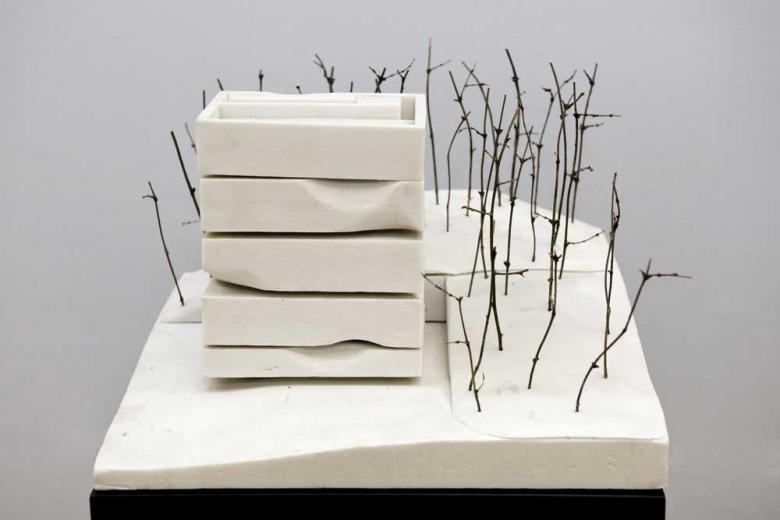Architecture China - The 100 Contemporary Projects
Architecture China - The 100 Contemporary Projects
24. October 2012
In the German city of Mannheim an exhibition shows 100 contemporary architectural projects from China. The show was curated by Fang Zhenning for the Chinese cultural year in Germany, to celebrate the 40th anniversary of diplomatic relations between the two countries. Earlier the exhibition was shown in other European cities.
OCT Design Museum, Shenzhen, 2011
Architecture: Zhu Pei
Photo: Fang Zhenning
Each of the 100 projects is presented with one huge photograph or rendering and occasionally with a model. The renderings are so perfect that for the layman it is difficult to differ them from photographs. In a few cases power point presentations or short films give additional visual information. However, the only criteria for the exhibition seem to be the fact that the buildings stand in China – with one exception for a project from Taiwan.
CCTV, Beijing, 2012
Architecture: Rem Koolhaas (OMA)
Photo: Fang Zhenning
Architecture: Rem Koolhaas (OMA)
Photo: Fang Zhenning
There is no explanation other than the political claim in Beijing, to represent also the island of Taiwan. The shown projects include railway stations, museums, campus buildings, clubhouses, hotels, schools and so on. Since each project is only presented with one photograph or rendering – with a few exceptions – the visitors rely on the very short general descriptions. Without drawings and context, the impression is given of an exhibition about photography.
CIPEA4 House, Nanjing, 2011
Architecture: Zhang Lei
Photo: Carolin Breckle
The show is sponsored by the Chinese Ministry of Culture and presents architectural development in the last ten years rather like a publicity campaign. About a quarter of the projects are designed by foreign firms like OMA, Zaha Hadid, Herzog & de Meuron, David Chipperfield, gmp or I.M. Pei. A further quarter shows projects by young private practices, like urbanus, amateur architecture studio, Wang Lu, Zhang Lei, standardarchitecture or Studio Pei-Zhu, shown on www.chinese-architects.com.
Lhasa Railway Station, Lhasa, 2006
Architecture: Cui Kai
Photo: Zhang Guangyuan
The two extremes in the show are represented on one hand by the railway station in Lhasa, Tibet, designed by Cui Kai from the China Architecture Design & Research Group in Beijing and on the other hand a series of follies, designed by Wang Yun of Atelier Fronti, also from Beijing, for the Xixi Wetland Park in Hangzhou. The railway station in Lhasa, designed with reference to the historic Tibetan palace architecture, consists of a huge hall for several tracks – with currently five trains arriving every day.
Ningbo History Museum, Ningbo, 2008
Architecture: Wang Shu, Lu Wenyu (Amateur Architecture Studio)
Photo: Fang Zhenning
The technical infrastructure building, based on “interpreted” traditional design, reflects political adaption in the fitful situation in Tibet. The associated monumental expression shows the expectations of many decision-makers, not only in the province. Even more interesting and more complex are the series of follies by Wang Yun for the Xixi Wetland Park in Hangzhou. The magazine Architectural Review covered the story behind the buildings in its last issue (http://www.architectural-review.com/buildings/xixi-wetland-center-in-china-by-atelier-fronti/8634587.article).
Surplus, Beijing, 2007
Architecture: Miao Xiaochun
Photo: Carolin Breckle
Like in many other cases, the local clients commissioned the architect with an open program, but without a user. The architect designed a series of pure white, hard-core modernist follies, which – due to vacancy – now begin to crumble. This example shows best that current Chinese practise, to build without user, can end with problems. The potential users are shy with such strange, abstract compositions and never have heard what the architect associates with his formal expressions: here obviously liberal western avant-garde of the 1920s. In this case, the wet climate and the mediocre execution without constant maintenance, reinforce the appearance of a modern ruin. Maybe this is the reason, why the project is shown with many clean white models and black & white photographs.
Phoenix International Media Center, Beijing, 2012
Architecture: Shao Weiping
Visualization: Shao Weiping (BIAD_Ufo)
Phoenix International Media Center, Beijing, 2012
Architecture: Shao Weiping
Visualization: Carolin Breckle
But the phenomenon, to build without user and an unprofessional maintenance, are huge unsolved problems for the contemporary development. Such information as given for the two examples above, is not found in the exhibition. The visitor stays alone with glossy photographs, which show an idealised architectural status quo, but leave out the opportunity to reflect critically the values in architectural and urban development in contemporary China. However, for the laymen the show gives a first visual impression of Chinese architecture in the 21st century. A thoughtful discourse on the development seems impossible as long as the government only wants to use such exhibitions to decorate the radical modernisation of the society.
Eduard Kögel
Impression of the Exhibition
Photo: Carolin Breckle
Impression of the Exhibition
Photo: Carolin Breckle
Architecture China –
The 100 Contemporary Projects
Reiss-Engelhorn-Museen
Museum Zeughaus C5
Mannheim
Exhibition
16.9.2012–13.1.2013
Curator
Fang Zhenning
A catalogue was published in
English and Chinese
www.rem-mannheim.de









